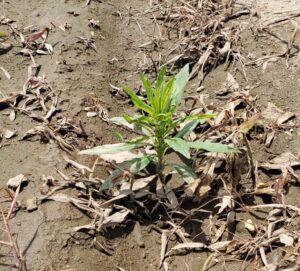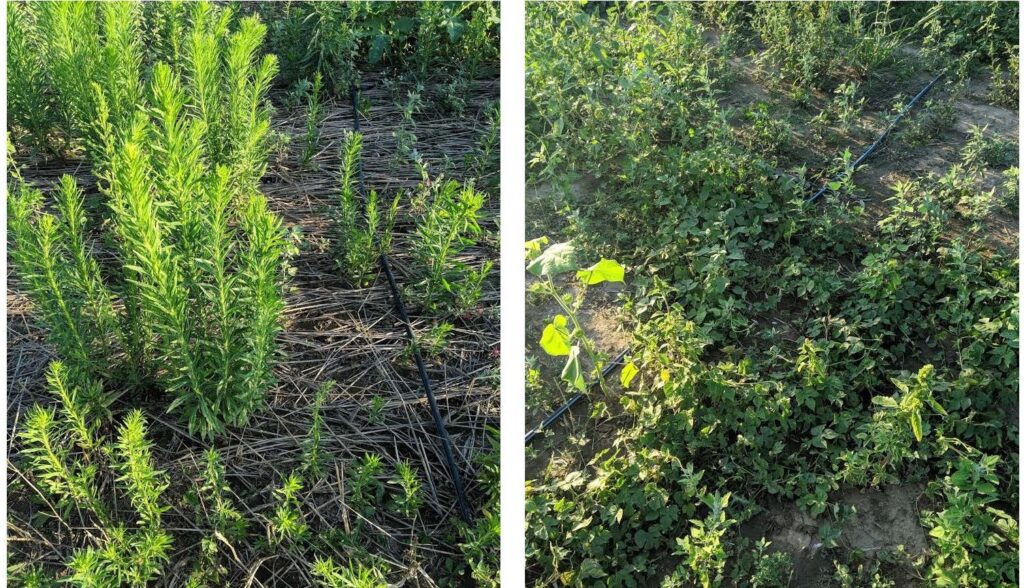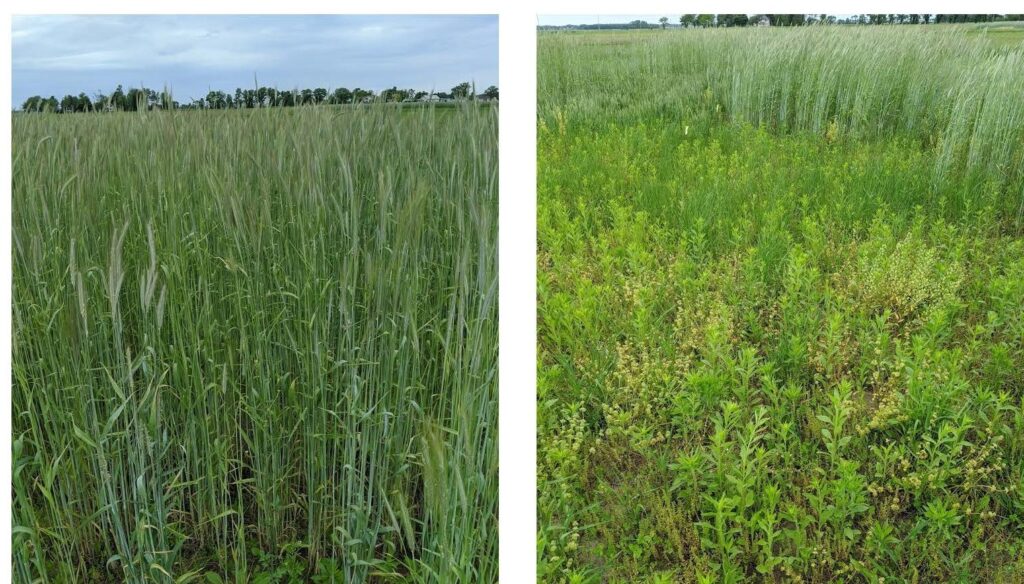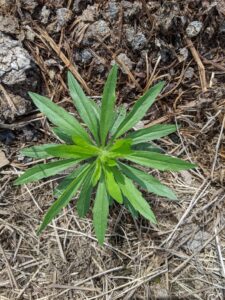Scientific names: Erigeron canadensis or Conyza canadensis
Horseweed, also known as marestail, fleabane, or colt’s tail, is a common and troublesome weed throughout North America due to its high seed production, wind dissemination, lack of seed dormancy, and adaptability to dry and moist soil. Moreover, horseweed populations have shown to be resistant to Group 2 (ALS-inhibitors) and Group 9 (glyphosate) herbicides.

Figure 1. A likely resistant horseweed plant continues to grow following a glyphosate (Group 9) application in northern Indiana (Photo by J. Arana).
Historically, horseweed has had many uses. Native Americans in the Zuni River Valley of New Mexico inserted crushed horseweed flowers into their nostrils to stimulate sneezing and help relieve rhinitis. Other Native Americans used the leaves to treat sore throat and dysentery. Dried plants were scattered in animal bedding to prevent fleas. Young leaves were used as a flavoring substitute for tarragon.
Identification: Seedling is a basal rosette. Cotyledons are oval, and young basal leaves are egg-shaped with toothed margins. After the stem elongates, basal leaves deteriorate. Stem leaves are lanceolate to linear with nearly entire margins and become gradually smaller up the stem (Figure 2).
Growth habit: Erect, annual that can reach six feet tall. It can either be a summer or winter annual. Seeds that emerge in fall result in overwintering rosettes that bolt the following spring. Seeds that emerge in spring result in plants that bolt in early summer.
Reproduction: Flowers from July through October from a terminal panicle can produce 200,000 seeds per plant. Seeds are between 1 to 1.2 mm and accompanied by whitish bristles (pappus) that facilitate wind dispersal more than a quarter mile. Approximately 86% of the seeds germinate quickly due to lack of dormancy.
Integrated weed management strategies:
Cultural and mechanical practices:
- Cultivation and planting date: A planting date in mid-May that follows spring tilling will reduce horseweed populations (Figure 3). Weeds that emerge after tilling can be controlled with burndown pre-planting applications.
Growth habit: Erect, annual that can reach six feet tall. It can either be a summer or winter annual. Seeds that emerge in fall result in overwintering rosettes that bolt the following spring. Seeds that emerge in spring result in plants that bolt in early summer.
Reproduction: Flowers from July through October from a terminal panicle that can to produce 200,000 seed per plant. Seeds are between 1 to 1.2 mm and accompanied by whitish bristles (pappus) that facilitate wind dispersal more than a quarter mile. Approximately 86% of the seeds germinate quickly due to lack of dormancy.
Integrated weed management strategies:
Cultural and mechanical practices:
- Cultivation and planting date: A planting date in mid-May that follows spring tilling will reduced horseweed populations (Figure 3). Weeds that emerge after tilling can be controlled with burndown pre-planting applications.

Figure 3. Spring tillage influences the types of weeds present. Horseweed is far more abundant in no-till plots (left) while other weeds are more abundant in plots with conventional tillage (right) (S.L. Meyers).
- Crop rotation: Horseweed is not tolerant of shade. In areas with heavy horseweed infestations, consider rotating to high-density and upright crops that are more competitive with weeds. Corn (field corn, sweet corn, or popcorn) is an example of an upright and competitive crop that also has numerous effective herbicides for managing broadleaf weeds, including horseweed.
- Mulching: Polyethylene (plastic) mulch reduces emergence near the crop as horseweed cannot grow through it. Carbon-based mulches, including terminated cover crops, can also be effective if they are present with sufficient biomass.
- Cover crops: Fall-seeded cereal crops like cereal rye can compete with both fall emerging and spring emerging horseweed (Figure 4). Termination of the cover can consist of mechanical (rolling/rolling-crimping, mowing, plowing) and/or chemical methods (synthetic or OMRI-approved herbicides) to help control escape horseweed.

Figure 4. Horseweed is suppressed by a cereal rye cover crop (left) compared to bare ground plots receiving no fall cover crop (right) at Wanatah, Indiana (Photo by S.L. Meyers).
Chemical control:
Fall management: In recent years there has been a push to manage troublesome winter annual weeds, including horseweed, with fall-applied herbicides and in some cases the combination of both postemergence and residual herbicides. In many years this practice is not possible because there is very little time between when crops are harvested and when winter weather prevents access to fields. If time and conditions permit, consider using only a postemergence herbicide in the fall. The use of residual (preemergence) herbicides promotes bare soil, which can result in erosion and is counter-productive for healthy soils.
Burndown options: Because glyphosate-resistant horseweed populations are wide-spread, a glyphosate-only application is not likely to provide sufficient control. Consider glyphosate tank-mixed with an auxinic herbicide (dicamba or 2,4-D), saflufenacil (Sharpen®), or carfentrazone (Aim®) depending on the crop to be planted. Target horseweed plants in the rosette stage. Controlling bigger plants is difficult and may require a follow-up mechanical control measure. For cool season crops planted in the spring, a soil-applied residual herbicide may be necessary to control spring-emerging horseweed. Consult the Midwest Vegetable Production Guide (mwveguide.org) for crop-specific recommendations. You can see some horseweed burndown strategies demonstrated in this Purdue University Extension video by Dr. Bill Johnson and Marcelo Zimmer https://www.youtube.com/watch?v=TevnpknMbGE.
